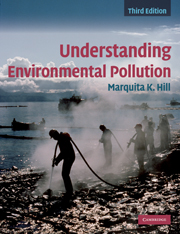Book contents
- Frontmatter
- Contents
- Preface
- Acknowledgements
- List of abbreviations and acronyms
- 1 Understanding pollution
- 2 Reducing risk, reducing pollution
- 3 Chemical toxicity
- 4 Chemical exposures and risk assessment
- 5 Air pollution
- 6 Acid deposition
- 7 Global climate change
- 8 Stratospheric ozone depletion
- 9 Water pollution
- 10 Drinking-water pollution
- 11 Solid waste
- 12 Hazardous waste
- 13 Energy
- 14 Persistent, bioaccumulative, and toxic
- 15 Metals
- 16 Pesticides
- 17 Pollution at home
- 18 Zero waste, zero emissions
- 19 Chemistry: some basic concepts
- Index
- References
19 - Chemistry: some basic concepts
Published online by Cambridge University Press: 05 June 2012
- Frontmatter
- Contents
- Preface
- Acknowledgements
- List of abbreviations and acronyms
- 1 Understanding pollution
- 2 Reducing risk, reducing pollution
- 3 Chemical toxicity
- 4 Chemical exposures and risk assessment
- 5 Air pollution
- 6 Acid deposition
- 7 Global climate change
- 8 Stratospheric ozone depletion
- 9 Water pollution
- 10 Drinking-water pollution
- 11 Solid waste
- 12 Hazardous waste
- 13 Energy
- 14 Persistent, bioaccumulative, and toxic
- 15 Metals
- 16 Pesticides
- 17 Pollution at home
- 18 Zero waste, zero emissions
- 19 Chemistry: some basic concepts
- Index
- References
Summary
This chapter assumes that the student has had little or no chemistry. First, recognize that chemicals are not something “out there.” The whole Earth is composed of chemicals. So is your body. You breathe in chemicals with each breath, you eat chemicals – all food is composed of chemicals – and you excrete chemicals. So chemicals are not just synthetic chemicals, i.e., not just chemical pollutants. Rather, everything you touch, taste, or smell is chemical in nature.
After introducing necessary concepts, the chapter selects several pollution issues from earlier chapters in this text and explains them from a simple chemical perspective. Section I introduces the atom and its subatomic particles, as well as isotopes; and then goes on to chemical bonds and valence. Section II overviews organic and inorganic chemicals, and then moves on to free radicals and their capability to sometimes help solve pollution problems but, in other cases worsening them. Section III looks at oxidation reactions from the perspective of burning fossil fuels. Avogadro's constant and the mole are also introduced. Finally, Section IV uses simple chemistry to overview two major acid pollution problems: acid deposition and ocean acidification.
SECTION I
Atoms
An element is the fundamental form of matter. Each element is composed of atoms, which cannot be further subdivided. There are 92 natural elements. Among them are familiar names such as iron, gold, sodium, calcium, and carbon. ▪ The atom of every element contains a nucleus and a shell of electrons.
- Type
- Chapter
- Information
- Understanding Environmental Pollution , pp. 539 - 561Publisher: Cambridge University PressPrint publication year: 2010



